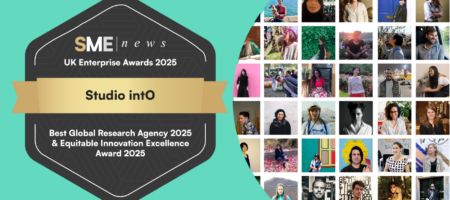The team at intO have been enjoying a return to IRL (in real life) fieldwork when recent briefs have called for such, now that many global regions have lifted social restrictions and opened borders to travellers. However, remote and online research methodologies are now a mainstay of the researcher’s toolkit. In this article, Research Director, Chloe Amos-Edkins, explains why a blend of both in-person and online is often best.
The fuel behind globalisation & multinational research
We’re all aware that digital technology has fueled cross-border business, reducing the cost of international interactions and transactions, and creating markets and user communities with global scale – as well as the means to reach them. It’s also driven the growth of international commercial research – both in response to the needs of globalising businesses and as a result of the very same practicalities and benefits delivered by digital enablement.
As a worldwide and remote-first business, Studio intO has always relied upon digital technology to operate, keeping our globally-distributed team of researchers connected and collaborating. The structure of our team means that we almost always have a researcher – on-the-ground, in the same time-zone, with an understanding of the cultural context and native language fluency – in any region we research in. However, our familiarity with a broad suite of digital tools meant we were also early adopters of online qualitative research methods; we know from experience that they are able to deliver useful, actionable insights.
An acceleration for remote and online methods
Before 2020, some of these online methods, like virtual digital safaris, mobile ethnography, netnography and virtual stakeholder workshops, could have been deemed fairly experimental in comparison to traditional qualitative research methods. But just as the pandemic forced so much of life online, so it necessitated that our fieldwork during this time – with only a very few exceptions – was remote and digital.
In one study, which involved the redesign of Air China’s VIP lounge during lockdown in China, our local researcher was unable to access Beijing Capital Airport, so instead we organised for one of the skeleton staff there to provide a live, virtual immersion into the environment via his mobile device.
Pre-pandemic, one of the methods we almost always conducted in person was the stakeholder activation workshop. Workshop facilitators are skilled at identifying non-verbal cues and interpersonal styles ‘in the room’ – and apart from anything else, we enjoyed this opportunity to spend time and connect with our client teams. During the pandemic, we designed virtual, 100% remote workshops that continue to be the best option for many of our clients (although it’s interesting to note that many are preferring to revert back to in-person workshop experiences. The prospect of being in the same physical space as colleagues and peers is more exciting and engaging for some – and there’s no doubt that it offers a break from zoom fatigue).
Will a total shift to online methods stick?
There are obvious benefits to online methodologies: cost, agility and accessibility. In addition to the time and money spent on travelling to conduct in-person fieldwork or workshops, most digital tools offer efficiencies when it comes to sorting and analysing data; our virtual workshops that are hosted on Miro, for example, completely negate the need to transfer hundreds of Post-it notes from a physical workshop facility to the studio desk – all the while maintaining an integrity of order, and with the task of deciphering different styles of handwriting still ahead. A more diverse set of global stakeholders can be involved in online workshops, and the same usually applies to research participants in studies, too. This broadens the opportunity for exploration, discovery and inclusivity.
It’s not only researchers and stakeholders who appreciate these benefits delivered by online methods. We may see lasting preferences amongst research participants due to a shift in expectations. Many people have become used to limiting contact with people who aren’t part of their close circle. In addition, they are also used to being paid while online in a home environment; the motivation to travel to UX labs or focus groups may be harder, now and in the future, to incentivise.
The choice shouldn’t always be decided by cost, speed or accessibility
However, choosing between in-person or online methods shouldn’t ever come down to practicalities alone. Methods should always be driven by the context of the research – including the position of the commissioning business and those situations relevant to the people that the study seeks to understand.
Our recent work for Miro focused on redefining the platform’s user personas. The brand had experienced extraordinary growth during lockdown’s period of remote working and the ambition to grow its user-base (including the use cases served) by an additional 236%, over three months, necessitated a deeper understanding of user journeys to the product and needs. The mixed methods we used – including a quantitative surveys, in-depth user interviews, digital ethnography and diary studies – were 100% online. But that’s because Miro is an online platform that enables distributed teams to collaborate. ‘Online’ was the key, critical context for these particular users. However, now that hybrid or office-based working is returning, Miro will likely be interested in understanding users of its product in physical team-centric environments.
The physical can be a vital part of the context
From an obvious starting point, immersive cultural trips are usually not only about experiencing the visual and aural dynamics of a place [via a screen], but also the smells, colours, weather, textures – and so much more.
Research objectives often call for ethnography and ethnographic interviews to take place in-person. Contradictions between what people say they do, and what they actually physically do (for example, when routinely interacting with a product’s packaging), can be very subtle and benefit from close, in-person situational observation.
Similarly, other methods in the field often depend on being ‘there’. During recent fieldwork in Paris for a micro-mobility brand, the brief was focused on the logistics of collecting and re-distributing bikes and scooters. While technology can identify the GPS location of a vehicle, it may not be able to report on its condition or cleanliness, or whether it’s toppled over and become a hazard.
The influence of culture on context and methods
Researching ‘in context’ means understanding the cultural underpinnings of a person’s experience and being able to factor that into what is learnt – and also into how the research methods are designed in the first place.
Different digital tools that enable methodologies will be more or less suited to research in different regions. On a practical level, some are only really usable with a good understanding of the English language, and some are not available in specific countries at all. Some will require a greater sophistication of technology – whether proficiency, hardware or connection speed – that isn’t readily accessible to the majority of preferred participants.
In the global south, among most generations, smartphones have become a natural extension of our ‘being’. The well-established method of mobile ethnography is often a solid approach to take when seeking to understand the routines and patterns of ‘normal life’. Here, participants may be briefed to take pictures, video and voice recordings as they move through weeks, days, specific tasks, etc. In the global south, using a smartphone doesn’t intrude or alter our natural behaviour as much as being accompanied and/or filmed by a researcher. However, if participant criteria was focused on a region or demographic that had less smartphone penetration (for example, India or Uganda), and participants had to be ‘given’ a device to take part in the study, the device may run the risk of stealing the show and polluting the insights.
In-person and online methods will never be ‘binary’ options
Personally, I’m enjoying getting back into the swing of ‘real life’ interactions with colleagues, clients and research participants, but I know that online methodologies will continue to expand the breadth of our research toolkit and present fresh solutions to former compromises. Few people live in a binary online/offline world today. There are few physical services that are not provided via a digital interface – and that’s before we’ve even scratched the surface of the metaverse. Our lives – not just our working lives – will increasingly become more hybrid, so how we approach understanding those lives will too.
Chloe is intO’s Research Director. Learn more about Chloe here and connect with her on LinkedIn, here.
Posted on April 25th, 2022
Methods Publications Research



